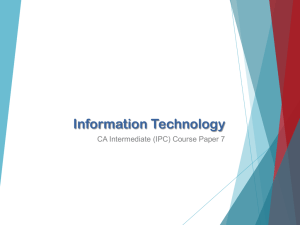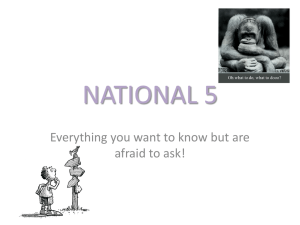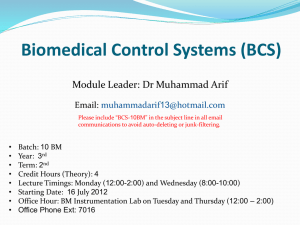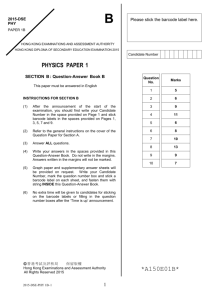Success in Exams - History @ St Benets
advertisement
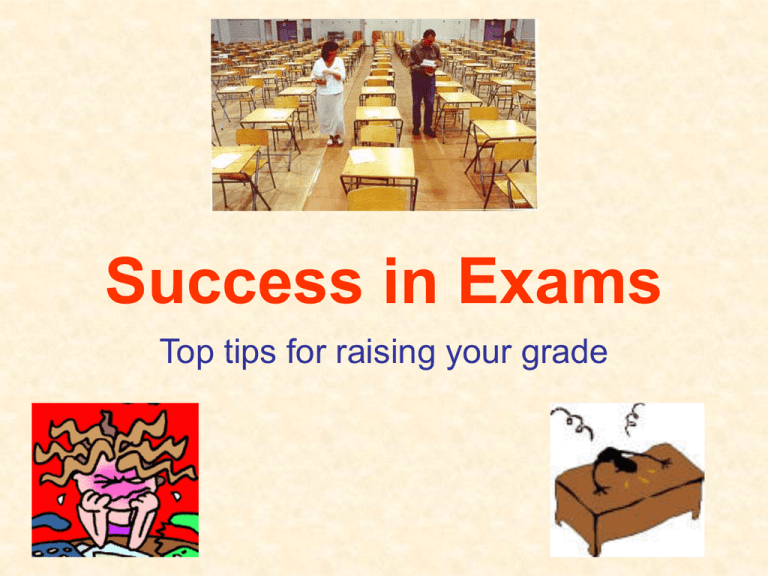
Success in Exams Top tips for raising your grade Before we start… • “When you believe, you can achieve” • “Whether you think you can or whether you think you can’t, you’re probably right” • In other words, self-confidence is the key to success Programme Outline 1. 2. 3. 4. Exams – what are the problems? What are exams actually testing? How are exams marked? Top tips for exam success - How can I improve exam technique? Objectives 1. Develop understanding of what examiners are actually looking for. 2. Improve your examination skills and selfconfidence in exam situations. 1. Exams – what are the problems • In pairs, spend a few minutes discussing what you feel are main reasons why students often find exams difficult. 2. What are exams actually testing? • Exams are basically assessing three things: 1. Knowledge – how much you remember about a topic e.g. the recall of facts. 2. Skills – your ability to use practical skills e.g. interpreting sources. 3. Understanding – the application of knowledge e.g. testing your ability to evaluate, analyse, etc. 3. How are exams marked? Most exams are marked using two main methods: 1. Short questions (generally four marks or less) are usually point marked. This means that each correct statement gets a mark. The very shortest questions may be one mark for a correct one word answer. E.g. How far is it from X to Y? Elaboration Developing a point or argument will gain more marks. E.g. Let’s suppose that you are asked look at an O.S. map and “identify problems caused by the physical landscape”. “The landscape is hilly, with steep slopes” (1 mark ) “shown by the closeness of the contours in 23,45” (+1 mark) “which makes it difficult for farmers to use machinery” (+ 1 mark) “therefore only sheep farming is possible” (+ 1 mark) 2. Longer questions (generally more than five marks) are level marked. This means that they are marked according to the quality of the answer. For example, a six mark question is likely to be marked in three levels: • Level 1 (1 – 2 marks) Basic details / Simple understanding / Little organisation / Few links • Level 2 (3 – 4 marks) Greater detail / Clear understanding / Organised answers / linkages / possible examples • Level 3 (5 – 6 marks) Detailed / Accurate information in correct context / Elaboration / Case studies / Links Example: Explain the location of volcanoes (6 marks) How many marks is this answer worth? “Volcanoes are found near the edge of plates. They are formed because of the movement of plates”. How could this answer be improved ? You have 3 minutes to work with a partner to show how this answer could be improved 4. Top tips for exam success - How can I improve exam technique? • The following tips are practical ways in which you can improve your exam grades through better techniques Avoid Common Errors • • • • • • Misreading the questions. Too much irrelevant information. Failure to answer the exact question asked. Lack of detail in the answer. Lack of case study information. Not using the supporting resources properly - either ignoring them or copying information word for word. Use your skills • If the exam includes source material, remember that the examiners have spent time and money including this for a reason. • Demonstrate your skills by extracting relevant information to use in your answers. Identify trends, patterns, etc and offer explanations. What can you tell from this image? Struggling – try the 5 W’s What? Who? Why? When? Where? Practice Exam Technique Get familiar with the structure of exam questions. Many candidates struggle not from lack of subject knowledge, but they are unable to understand exactly what the examiner is asking. If you do enough past exam questions you may start to see patterns. Essay Questions Long essay questions pose their own particular challenge. Plan your answer. Spend a few minutes drawing one at the start. If you think you may be running out of time write a conclusion, and answer the original question directly. Then, using bullet points, list enough other stuff to justify your conclusion. Learn the formula for success Most longer questions, particularly on the Higher Tier Paper, are looking for your ability to link e.g. features, processes and locations in Geography E.g. “A volcano (feature) can be caused by subduction (process) at a destructive plate boundary, such as Nevado del Ruiz in Colombia, as the Pacific Plate is dragged beneath the south American Plate (location)”. Look carefully at the mark allocations It is amazing how many candidates leave massive spaces in their answer booklets. Remember that the spaces are a guide to how much to write. The more marks that are available, the longer your answer should be. Marks are not taken away for irrelevant answers, you just don’t gain them. It is therefore worth adding bits that you are not totally sure about to the end. Understand how questions are marked Remember that the questions worth four or more marks are usually marked in levels (according to the quality of your answer). Top marks require good knowledge /skills /understanding, added to the ability to elaborate, make links and locate examples. Using sketches/diagrams almost always score a high mark when done properly. Location, Location, Location !!!!! OK this applies mainly to Geography, but remember if you have studied your GCSE subject for at least 2 years. You need to include case study detail in many subjects. The examiners are told to give credit if something “rings true” (sounds possible /likely). If you are stuck for locations, etc. then think about local examples. Timing Work out the formula for time and marks for your paper. E.g. if there are 2 hours and 60 marks, then you should spend about two minutes per mark. Having lots of time left over at the end is never a good sign - go back and check all of your answers again. Understanding Questions • Make sure that you understand the meaning of all the questions before you answer them. • Underling key words can be helpful., particularly for those questions worth four marks plus. While waiting for the exam to start - read the front cover so you know what exactly to do Read each question carefully twice is better than once Check how many marks are available - write ‘enough’ Answer the question - underline or circle the key words. Must be done!! Where is it? What is it near? Size? “Name a factory. Describe the site and explain why the location was chosen” Give reasons.. This is because…. Write your answer when you feel confident - if not - leave it and go to the next one Check all calculations - does the answer make sense? Check information in graphs, tables and pictures. Did you use your ‘subjectspecific’ words? Check spellings and answers through Use a sharp pencil to draw diagrams and graphs If you run out of time do a plan for an answer. Get some sleep before the exam Leave time to review - check and double-check your work When time is up - finish and forget. You’ve another one soon.. Describe The number of International Tourists 325 300 300 275 250 225 Millions 200 175 150 125 100 100 75 50 50 25 5 0 1961 10 1971 1981 Tim e 1991 2001 Explain This is because... The number of International Tourists 325 300 300 275 250 Millions 225 200 175 150 125 100 100 75 50 50 25 5 0 1961 10 1971 1981 Tim e 1991 2001 Tell me why... Compare Man A Man B Man A is ….. whereas man B is ….. (look for similarities and differences) Evaluate What was successful? What was not successful? Advantages Disadvantages With the help of …. Suggest Tell me why.. Give reasons… It happened because
